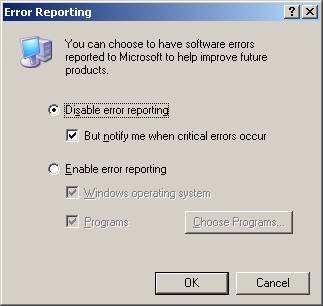
- #Microsoft error reporting pop up how to
- #Microsoft error reporting pop up install
- #Microsoft error reporting pop up full
- #Microsoft error reporting pop up windows 10
- #Microsoft error reporting pop up software
Selecting the correct option will help us better understand what’s happening. In case you want to report a bug or error, simply click the button labeled “Report a problem.” After that, you’ll see a pop-up asking you to select the type of issue you’re experiencing.
#Microsoft error reporting pop up install
When you install a new device, Windows Error Report pops up in a Notification Window. If you find something wrong with the operating system, you can click “Send Feedback,” and Windows Error Report will do the rest. You can use it to submit issues regarding Windows Store apps, Windows Phone apps, and even Windows itself.
#Microsoft error reporting pop up windows 10
This tool gives you a chance to report bugs and errors related to Windows 10 directly to Microsoft. Windows 10 error report is one of those features that many people don’t know about. How does the windows error reporting service work? This way, you won’t receive any notifications about issues that occur during startup. However, if you don’t know what it does, you might want to disable it altogether. If you see Werfault.exe running in Task Manager, you can stop it there.

You might want to check out our guide to fixing Werfault.exe errors.
#Microsoft error reporting pop up software
If Werfault.exe stops working, it could indicate a hardware or software issue. These processes run automatically once you start up your computer. They report problems such as crashes, freezes, and hangs. Werfault exes are part of Microsoft’s Windows operating system. What is a windows error reporting service?
#Microsoft error reporting pop up how to
#Microsoft error reporting pop up full
This value states that only full process dumps are going to be collected.Īfter you finish, the new registry records should look similar to this:Ĭlose the registry editor, restart the machine so that the changes take effect, and reproduce the issue one or several times (depending on the MSP360 support engineer directions). After that, double-click it and assign it with a value “2”, then save again. Name the value as “DumpType” and save it. Select “New”, then “DWORD (32-bit) value”. This value defines how many crash dumps are going to be stored in the designated folder. After that, double-click it and assign it with a value “10”, then save again. Name the value as “DumpCount” and save it. This value defines where the crash dumps are going to be stored. After that, double-click it and assign it with a value “%LOCALAPPDATA%\CrashDumps”, then save again. Name the value as “DumpFolder” and save it.

Select “New”, then “Expandable String Value”. Select the newly created key and open a contextual menu on the right side of the Registry Editor window.

Under the “LocalDumps” key create a new key named exactly after the crashing process. Under the “Windows Error Reporting” key locate a “LocalDumps” key or create it if it’s not present (using a contextual menu). Navigate to the key “HKEY_LOCAL_MACHINE\SOFTWARE\Microsoft\Windows\Windows Error Reporting”. Solutionįirst, please identify the failing component of the application with an MSP360 support engineer (for example the “CBBackupPlan.exe” for crashing backup or restore plan, the “Online Backup.exe” or a similar but rebranded executable file for crashing GUI, etc.).Įnter “regedit” into the Windows search bar and open the registry editor with administrator privileges. In this article, we describe how to configure the Windows Error Reporting to automatically create crash dumps of the process(es) that experience reproducible crashes. For us to properly investigate the causes of such issues it would be necessary to look into the crash dumps of failed processes (using them as a vertical slice of the problem).

Reasons for the crashes could vary from insufficient system resources (overloaded CPU / RAM) to antivirus interventions to specific bugs. Below, for example, you can see an error pop-up indicating that the graphical user interface (GUI) of the Backup application has crashed: In some situations, a component of the MSP360 Backup application might crash. Using Windows Error Reporting to Collect Crash Dumps of the Backup Components Situation


 0 kommentar(er)
0 kommentar(er)
